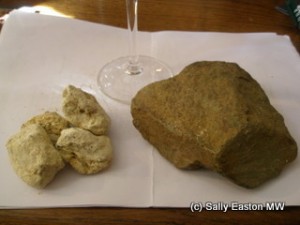Minerality – quote, unquote 3
Here’s a northern European selection of minerality quotes and comments from Germany and the Loire, with just one Champagne thrown in for good measure. There’s always more to follow.
Is the term minerality being used as a proxy for terroir association? Or as a direct expression of terroir? Or something distinct from terroir expression?
Feel free to read previous Quote, Unquotes, one and two.
Joachim Heger, Weingut Dr. Heger, August 2011
Of his main vineyard site on the Winklerberg: “there are more stones on the Winklerberg [compared to the stones and ash of Achkarrer Schlossberg], with limestone in the lava, which is almost unique. It’s more spicy, with salty minerality.” Weissburgunder Grosses Gewaches troken, Gras im Ofen from the Winklerberg expresses minerality for Heger.
Arne Bercher, Weingut Bercher, August 2011
Minerality is a “salty quality on side of tongue”
Bernd Kern of Rheinhessenweine, August 2011
“Minerality dries out your tongue at the end; like a white tannin.”

White degraded schist, and grey schist
Philippe Delesvaux of Domaine Philippe Delesvaux, August 2011
“I’ve noticed an increase in acidity and minerality with organic (certified) viticulture.”
Vincent Ogereau, of Domaine Ogereau, August 2011
“There’s a mineral dimension in Savennières that Anjou doesn’t possess.” He makes wine in both appellations, and the soils for all are schist. Even just within Anjou he has deep, white, degraded schists, and non-degraded solid, grey, schist.
Frédéric Julia, of Château de la Génaiserie, August 2011
Julia related levels of acidity in chenin blanc with minerality and the schist and slate soils on which it’s grown. He said Chaume “is full of schist, it’s a one stop for minerality.”
Claude Papin, Château Pierre-Bise, on Quarts des Chaume, August 2011
Quarts de Chaume is all on schist with patches of volcanic rock thrown in. A typical Quarts de Chaume, he said “has aromatic finesse marked by botrytis, with a balance between the mineral quality and the botrytis.”
In some detail he then explained: “Follow the grape as it ripens. After physiological ripeness wait for phenolic ripeness which is when the skin is the thinnest it can be, and still be healthy. Acidity at sugar ripeness is pure and direct and immediate but lacks elegance. Once you get to phenolic ripeness, acidity has taken on finesse, purity, it’s long, precise, complex. In relief, sugar ripeness is mono, phenolic ripeness is stereo. In stereo, you can identify where the individual instruments are in the orchestra. In phenolic ripeness of grapes, you should identify all the key factors that make up the flavour profile of the wine. Sugar ripeness acidity is sharpness. At phenolic ripeness acidity becomes minerality.”
Jacky Blot, Domaine de la Taille aux Loups, August 2011
Minerality is “something that expresses pebbles. It exists because the vines are worked on. Very often people express high acidity as minerality, and it’s not minerality. Minerality is vibrant for me, acidity is aggressive.”
“I want very dry wines, with very, very augmented minerality. If minerality is on its own, this makes a wine hard to drink. The slowness of fermentation gives fat and roundness to wine.” Blot’s fermentations take 4-5 months, often nine months in his cold cellar. He does no malo, and uses about 10% new oak in 100% oak fermentations/maturations (would such influence the presence or expression of minerality?)
Is there a link between ‘white tannins’ of Bernd Kern above (speaking of weisserburgunder and grauburgunder), and chenin blanc’s minerality?
Charles Sydney, Loire broker, October 211
picked up Papin’s point about ripeness: “All good chenin blanc producers in the Loire pick by hand in selective tris. A harvest with no rot is very unlikely to be ripe. Given chenin’s tendency to be acidic, it is essential to wait till the grape reaches full phenolic maturity before harvesting, bringing sugar and acid into balance but, as important, also bringing the tannins to ripeness, reducing the astringency.”
Floriane Eznack, winemaker at Champagne Jacquart, April 2012
“Minerality is a salty, smokiness in the mouth. Like you are walking along a cliff, breathing iodine salty breathe. As it develops, it’s smoky like ashes, and flint.” Or she said minerality is “like licking a stick of [blackboard] chalk as a kid.”



